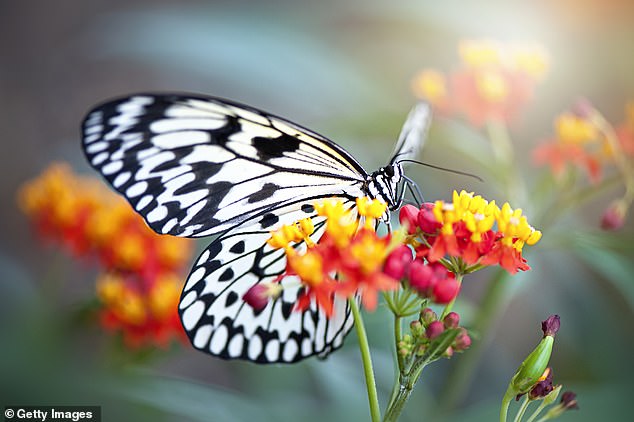NATURE
PLANTING FOR BUTTERFLIES
by Jane Moore (Hardie Grant £12, 144 pp)
Butterflies have poor eyesight, they can taste only with their feet and they have a lifespan of just a few weeks. Yet, during their brief existence, they provide one of the most joyful sights of summer as they feed, flutter and flirt for all they’re worth.
Why are they so bewitching? It’s not only their flamboyance or the fact that, unlike many insects, they neither bite nor sting. There is something mysterious about them, too.
Contrary to what our eyes tell us, butterflies actually have four wings rather than two, and those jewel-like colours are caused by ingenious three-dimensional scales on their wings which reflect the light.
British author Jane Moore, examines the lifespan of butterflies in a fascinating nature book. Pictured: stock image
Bizarrely, butterflies never actually eat. They only drink— whether nectar, water or the juice from rotting fruits — and the liquid is sucked up through a straw-like proboscis, which is neatly folded away when not in use. They are also masters of disguise. My favourite, the Comma, looks like a tatty bit of leaf when its scalloped wings are closed, only revealing its striking orange-brown markings when in flight or basking in the sun.
Worldwide there are more than 18,000 named species of butterflies. The UK has a fairly meagre 59 species of native butterflies, with another half-dozen that migrate here to breed during the summer months. Of these, writes gardener and butterfly enthusiast Jane Moore, three-quarters are in decline.
The culprits are the usual suspects — loss of habitat, modern farming practices, pollution and shifting weather patterns. Yet, as Moore points out, the decline needn’t be irreversible, and it’s gardeners who hold the key. Any garden, however small, can be planted to attract the creatures.
The key is ‘to manage your garden from a butterfly’s point of view’. The single most useful thing we can do is to let our lawns grow long, even if it’s just the odd shaggy corner. Plant a few wild flowers around the edges of the lawn and you’ll lure in even more types of butterflies. Basically, be a bit less tidy.

PLANTING FOR BUTTERFLIES by Jane Moore (Hardie Grant £12, 144 pp)
A butterfly’s ideal garden, Moore writes, would contain swathes of stinging nettles and plenty of brambles, on which they love to lay their eggs. Fortunately, there are also more aesthetically pleasing planting options.
Holly and ivy will attract the Holly Blue, while violets in a shady border will appeal to the Fritillary butterfly. Sweet rocket and honesty are favourite food sources for the Green-Veined White and the Orange Tip.
Moore lists dozens of other reassuringly familiar plants which are simply bursting with the nectar that butterflies need. The most well known is the buddleia, often known as the ‘butterfly bush’, and there are plenty of other cottage garden favourites such as sedum, scabious, valerian, Michaelmas daisies and lavender, as well as herbs including rosemary, marjoram and chives.
One of Moore’s top tips is to plant your flowers in blocks. As butterflies are near-sighted, a nice big bed of colourful flowers will act like a welcome mat for them: choose blooms in pink, purple, yellow and white rather than red, as this is a colour that butterflies can’t see.
Delightfully illustrated by James Weston Lewis, this small book packs a mighty punch. It’s not only crammed with information, but quietly persuasive — by the time I’d finished it I had been converted to the idea of making room for some nettles in a corner of my garden.
Even a small town plot like mine can play its part in the larger ecosystem because, Jane Moore promises, ‘plant the right plants, and the butterflies will come’.
